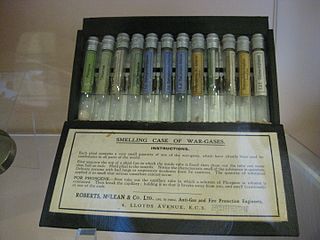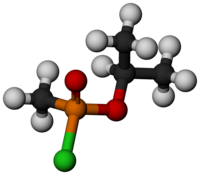
Phosgene is the organic chemical compound with the formula COCl2. It is a colorless gas; in low concentrations, its odor resembles that of freshly cut hay or grass. Phosgene is a valued industrial building block, especially for the production of precursors of polyurethanes and polycarbonate plastics.

Chemical warfare (CW) involves using the toxic properties of chemical substances as weapons. This type of warfare is distinct from nuclear warfare, biological warfare and radiological warfare, which together make up CBRN, the military acronym for nuclear, biological, and chemical, all of which are considered "weapons of mass destruction" (WMDs). None of these fall under the term conventional weapons which are primarily effective due to their destructive potential. In theory, with proper protective equipment, training, and decontamination measures, the primary effects of chemical weapons can be overcome. In practice, they continue to cause much suffering, as most victims are defenseless. Many nations possess vast stockpiles of weaponized agents in preparation for wartime use. The threat and the perceived threat have become strategic tools in planning both measures and counter-measures.

Sarin is an extremely toxic synthetic organophosphorus compound. A colourless, odourless liquid, it is used as a chemical weapon due to its extreme potency as a nerve agent. Exposure is lethal even at very low concentrations, where death can occur within one to ten minutes after direct inhalation of a lethal dose, due to suffocation from respiratory paralysis, unless antidotes are quickly administered. People who absorb a non-lethal dose, but do not receive immediate medical treatment, may suffer permanent neurological damage.

Tabun or GA is an extremely toxic chemical substance. It is a clear, colorless, and tasteless liquid with a faint fruity odor. It is classified as a nerve agent because it fatally interferes with normal functioning of the mammalian nervous system. Its production is strictly controlled and stockpiling outlawed by the Chemical Weapons Convention of 1993. Tabun is the first of the G-series nerve agents along with GB (sarin), GD (soman) and GF (cyclosarin).

Soman is an extremely toxic chemical substance. It is a nerve agent, interfering with normal functioning of the mammalian nervous system by inhibiting the enzyme cholinesterase. It is an inhibitor of both acetylcholinesterase and butyrylcholinesterase. As a chemical weapon, it is classified as a weapon of mass destruction by the United Nations according to UN Resolution 687. Its production is strictly controlled, and stockpiling is outlawed by the Chemical Weapons Convention of 1993 where it is classified as a Schedule 1 substance. Soman was the third of the so-called G-series nerve agents to be discovered along with GA (tabun), GB (sarin), and GF (cyclosarin).

VX is an extremely toxic synthetic chemical compound in the organophosphorus class, specifically, a thiophosphonate. In the class of nerve agents, it was developed for military use in chemical warfare after translation of earlier discoveries of organophosphate toxicity in pesticide research. In recent years, VX was found to be the agent used in the assassination of Kim Jong-nam. In its pure form, VX is an oily, relatively non-volatile, liquid that is amber-like in color. Because of its low volatility, VX persists in environments where it is dispersed.

The M687 is an American 155 mm binary sarin chemical weapon artillery shell. The design was standardized in 1976 and production began on December 16, 1987 at Pine Bluff Arsenal, Pine Bluff, Arkansas. Production was halted three years later, following the 1990 Chemical Weapons Accord between America and the USSR, and the dismantling of existing stocks began in November 1997 at Hawthorne Army Depot, Nevada. America's remaining stocks were stored at the Deseret Chemical Depot, Utah, and the Umatilla Chemical Depot.
Binary chemical weapons or munitions are chemical weapons which contain the toxic agent in its active state as chemical precursors that are significantly less toxic than the agent. This improves the safety of storing, transporting, and disposing of the weapon. Commonly, firing the munition removes a barrier between two precursors. These react to form the intended agent which is then aerosolized and distributed by a bursting charge.
Cyclosarin or GF is an extremely toxic substance used as a chemical weapon. It is a member of the G-series family of nerve agents, a group of chemical weapons discovered and synthesized by a German team led by Dr. Gerhard Schrader. The major nerve gases are the G agents, sarin (GB), soman (GD), tabun (GA), and the V agents such as VX. The original agent, tabun, was discovered in Germany in 1936 in the process of work on organophosphorus insecticides. Next came sarin, soman and finally, cyclosarin, a product of commercial insecticide laboratories prior to World War II.

VG is a "V-series" nerve agent chemically similar to the better-known VX nerve agent. Tetram is the common Russian name for the substance. Amiton was the trade name for the substance when it was marketed as an insecticide by ICI in the mid-1950s.

Many nations continue to research and/or stockpile chemical weapon agents despite numerous efforts to reduce or eliminate them. Most states have joined the Chemical Weapons Convention (CWC), which required the destruction of all chemical weapons by 2012. Twelve nations have declared chemical weapons production facilities and six nations have declared stockpiles of chemical weapons. All of the declared production facilities have been destroyed or converted to civilian use after the treaty went into force. According to the United States government, at least 17 nations currently have active chemical weapons programs.
Chemical, biological (CB) — and sometimes radiological — warfare agents were assigned what is termed a military symbol by the U.S. military until the American chemical and biological weapons programs were terminated. Military symbols applied to the CB agent fill, and not to the entire weapon. A chemical or biological weapon designation would be, for example, "Aero-14/B", which could be filled with GB, VX, TGB, or with a biological modification kit – OU, NU, UL, etc. A CB weapon is an integrated device of (1) agent, (2) dissemination means, and (3) delivery system.
Methylphosphonyl difluoride (DF), also known as EA-1251 or difluoro, is a chemical weapon precursor. Its chemical formula is CH3POF2. It is a Schedule 1 substance in the sense of the Chemical Weapons Convention. It is used for production of sarin and soman as a component of binary chemical weapons; an example is the M687 artillery shell, where it is used together with a mixture of isopropyl alcohol and isopropyl amine, producing sarin.

Isopropyl aminoethylmethyl phosphonite, also known as O-(2-diisopropylaminoethyl) O′-ethyl methylphosphonite, is a precursor chemical to the nerve agent VX. It is a colorless liquid with a strong fishy odor, and is slightly soluble in water.

A chemical weapon (CW) is a specialized munition that uses chemicals formulated to inflict death or harm on humans. According to the Organisation for the Prohibition of Chemical Weapons (OPCW), "the term chemical weapon may also be applied to any toxic chemical or its precursor that can cause death, injury, temporary incapacitation or sensory irritation through its chemical action. Munitions or other delivery devices designed to deliver chemical weapons, whether filled or unfilled, are also considered weapons themselves."
IDFP is an organophosphorus compound related to the nerve agent sarin. Like sarin, IDFP is an irreversible inhibitor for a number of different enzymes that normally serve to break down neurotransmitters, however the long alkyl chain of IDFP makes it dramatically weaker as an inhibitor of acetylcholinesterase (AChE), with an IC50 of only 6300 nM, while it is a potent inhibitor of two enzymes monoacylglycerol lipase (MAGL), the primary enzyme responsible for degrading the endocannabinoid 2-arachidonoylglycerol (2-AG), and fatty acid amide hydrolase (FAAH), the primary enzyme that degrades the other main endocannabinoid anandamide. The IC50 of IDFP is 0.8 nM at MAGL, and 3.0 nM at FAAH. Inhibition of these two enzymes causes markedly increased levels of both anandamide and 2-AG in the brain, resulting in increased cannabinoid signalling and typical cannabinoid behavioral effects in animal studies, while its lack of potency at AChE means that no cholinergic symptoms are produced.

The destruction of Syria's chemical weapons began on 14 September 2013 after Syria entered into several international agreements which called for the elimination of Syria's chemical weapon stockpiles and set a destruction deadline of 30 June 2014. On the same day, Syria acceded to the Chemical Weapons Convention (CWC) and agreed to its provisional application pending its entry into force on 14 October. Having acceded to the CWC, the Organisation for the Prohibition of Chemical Weapons (OPCW) Executive Council on 27 September approved a detailed implementation plan that required Syria to assume responsibility for and follow a timeline for the destruction of Syrian chemical weapons and Syrian chemical weapon production facilities. Following the signing of the Framework Agreement on 14 September 2013 and after the OPCW implementation plan, on 27 September the United Nations Security Council unanimously adopted Resolution 2118 which bound Syria to the timetable set out in the OPCW implementation plan. The joint OPCW-UN mission was established to oversee the implementation of the destruction program.

The Khan Shaykhun chemical attack took place on 4 April 2017 on the town of Khan Shaykhun in the Idlib Governorate of Syria. The town was reported to have been struck by an airstrike by government forces followed by massive civilian chemical poisoning. The release of a toxic gas, which included sarin, or a similar substance, killed at least 89 people and injured more than 541, according to the opposition Idlib Health Directorate. The attack was the deadliest use of chemical weapons in the Syrian civil war since the Ghouta chemical attack in 2013.














